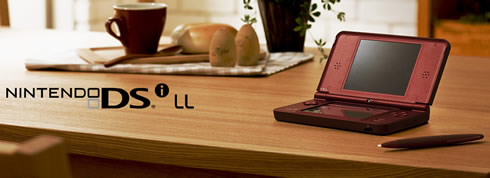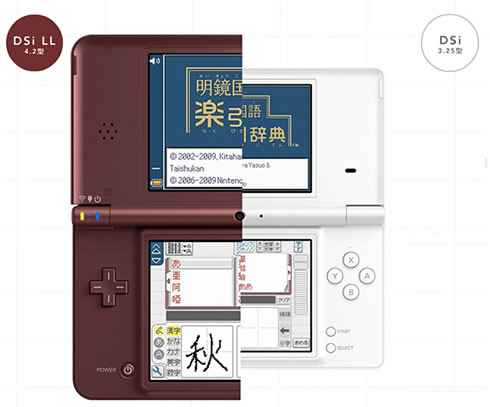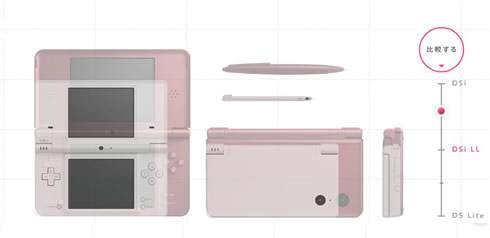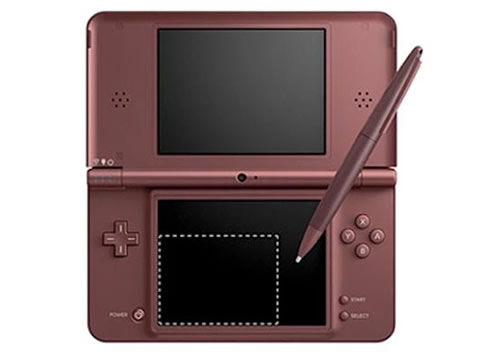
In with the old…
Following on from Cubed3’s illustrative comparison of the Nintendo DSi XL and various other systems and game-related items, now it is time to take a look at what makes it tick. For those that have yet to sample the DSi range, it is important to realise that although the system plays all existing DS releases, there are some features missing from the DS and DS Lite. First of all, the second slot at the bottom of the system has been removed, meaning that it is not backwards compatible with the Game Boy Advance range, nor can games such as Guitar Hero: On Tour be played, since titles such as Activision Blizzard’s music-based product use ‘Slot 2’ for accessories that are fundamental to gameplay. Additionally, whilst standard DS games still have no region restrictions, any titles that have DSi-specific features (using the camera in-game, for instance) or are entirely exclusive to DSi, will indeed be region locked.
The new aspects added to the hardware, however, counter-balance these omissions. Given the prominence of the ‘eye’ that appears to be staring at you when the DSi unit is closed, it proves to be a key focal point that will intrigue all new owners. It is in fact one of two cameras included in the system, with the other being an internal one that directly faces the player whilst the system is in use. Both cameras are 0.3 mega-pixels, which produce a standard photo size of 640x480. Clearly the DSi cameras were never intended to become replacements for a standard camera, but for the purposes of playing around with and adding fun extra modes to certain game releases (thanks to the motion detection feature that picks up head and hand movements), they certainly do their job more than adequately.
There is the option to have a photo of your choice act as the desktop background, with it showing whenever the system is booted up and menu navigation is taking place, adding a simple, yet effective, personal touch. In the actual full photo mode there are eleven pre-set effects to play around with, such as merging your face with another person’s, stretching shots, distorting an image into kaleidoscope form or merely adding moustaches and cartoon features before sending the final result to a friend using the local wireless functionality. As pictures are taken, they can be played around with to your heart’s content. Then, when editing has been completed, save them to a chosen album (saved chronologically to store memories and then use the slideshow mode to make the DSi into a digital photo frame), transfer them to an SD card or even upload them directly to Facebook.

Furthermore, sound plays a big factor on the DSi. On top of being able to play AAC-encoded music files from an SD card, there is a voice recording element. This allows for small snippets to be recorded, then the pitch and speed tweaked to amusing effect. Want to sound like a trumpet or budgie? No problem! In terms of 'proper' music playback, your favourite tunes can be edited, with equaliser effects such as ‘Radio,’ ‘Instrumental,’ ‘Echo,’ or even the very cool ‘8-Bit,’ which converts songs into an old school NES soundtrack.
The biggest draw has to be the DSiWare service, though, where DSi owners can download brand new titles and applications from the Nintendo DSi Shop directly to the 512MB of internal space on the hardware, copying content across to an SD card when necessary. Betweeen the initial line-up of Paper Plane (Paper Airplane), Pyoro (Bird & Beans), WarioWare: Snapped!, Art Style: AQUITE (AQUIA), Art Style: CODE (DECODE), and other high quality releases since the service commenced, such as Reflect Missile, 2-in-1 Solitaire, and Art Style: INTERSECT (DIGIDRIVE), it brings a whole new world of gaming into the palm of your hand. As an added bonus, your DSiWare account can be linked with your official Nintendo one so Stars can be accrued for every download, which can then in turn be converted into more Nintendo Points for the payment of future downloads.

...and in with the new!
Although Nintendo has stated that it believes the DSi XL is a ‘kinder, gentler DS’ as opposed to merely being a larger version of the hardware purely aimed at an older demographic, clearly the increased screen size and extra large pen included will appeal to those that found the screens on earlier DS units to be too small and the stylus too fiddly. Whilst the DSi screens jumped 17% in size to 3.25-inches when being upgraded from the DS Lite model, a much larger increase has been employed this time round, with the DSi XL coming with two 4.2-inch screens. Originally set to be a DS Lite XL a couple of years ago with 3.8-inch screens, units sales of the hardware were so high at the time that it made no sense to water down the manufacturing process. Putting the project on hold was certainly a wise decision, with the wait definitely being worth it as the cost of manufacture had significantly reduced after a couple of years had passed, meaning not only could 4.2-inch screens be used, but wide-angle viewing LCD screens that allow clear vision even from a side vantage point.Other than the cheaper cost factor, one of the primary ideas behind making the decision to go slightly larger and make the LCD screens wide-angled was that many people like to see what is going on when someone else is playing, so previously people have had to crowd around a DS and forcibly move closer to the system to see the action. However, now the system can easily be viewed by two people, first of all due to the new screen type, and secondly as the system's top screen can be placed at different opening angles thanks to its two hinge positions. Rather than just the 155 degree angle of the DS, now there is a 120 degree option available. This second position was included so that the machine could easily be left open on a table-top, encouraging other members of the family to simply jump straight in and play once someone has finished with the system, or so that anyone sat down playing a game could easily be watched, making it simpler to receive a helping hand in the Professor Layton series of games, as well as others of its ilk.

Other aesthetic changes of note include a slightly larger power button and easier to adjust volume tabs. Even the standard stylus is marginally longer than previous designs. For those that still have trouble with the thin stylus, there is an extra choice of using the thick pen-like version included in the box. This pen is made of three components moulded together, and the key factor is that one of these pieces protrudes like the clip on a pen. This is no accident, with it being done so upon finishing a gaming session, leaving the DSi XL behind on a tabletop, the pen can be left on the same flat surface without it rolling away and potentially becoming lost down the back of a radiator or gap in the floor-boards. The extra size of the DSi XL may be seen to be a disadvantage by some, since it means that more weight has been added. However, it is actually only 100-grammes heavier than a DSi, with the change in weight feeling negligible when held, even for long periods of time. The shape has been altered as well, with it no longer being a uniform cuboid. Nintendo has styled it in the form of an inverted trapezium, done so in order to make opening the lid less awkward.
On the sound front, Nintendo was hoping to increase the volume of the hardware in general, yet due to all the internal components remaining the same, upping the level on the current speakers would have distorted the sound too much. However, a solution came in the form of changing the speaker holes from the two small horizontal ones of the DSi to two sets of seven tiny holes set in a circular pattern of six, with the final hole located right in the centre. This has resulted in a clearer audio experience overall, and the reality that everything sounds a little louder than before despite being the actual same speaker as in the DSi model.
As for the colours Nintendo has chosen to release the DSi XL in, for the Japanese launch there was Dark Brown, Wine Red and Natural White. Initially the Wine Red choice was not going to be made available, but the disparity between the white and brown made the two models clash when promoted side-by-side. Introducing a third colour alleviated such problems for the marketing team and has in fact now proven to be the most popular selection, not only amongst the older demographic, but younger women as well, a sector Nintendo presumed would opt for the Natural White model instead.
Whether Nintendo sticks with these three launch colours is yet another aspect that remains unconfirmed at the time of writing for the US market, but no doubt plenty of behind-the-scenes market research is being conducted to come to a final conclusion. Europe is set to get the Dark Brown and Wine Red models. These colours are not just plain either, as with older models. Taking the Wine Red model that Nintendo sent out to Cubed3, there are four thin layers of two-tone plastic with coloured ink printed on to create a polished top panel, rather than merely one flimsy, cheap-looking cover like the protective cases being sold by Third Parties accessory producers right now that clip onto the system. The DS Lite and DSi models were meant to have had two-tone colour selections, but their complicated hinges meant the desired outcome could not be reached without the end result looking less than professional in Nintendo's eyes. The shiny top panel is not just flat either, with it swelling slightly, being designed to mimic the surface tension of water in a bowl, giving not only a gentle feel, but a smart finish as well, and adds a touch more protection to the external camera eye.

Image courtesy of Kotaku
Once the DSi XL has been booted up, the menu layout is the same, with all pieces of software and applications represented by boxes lined-up in a horizontal row, with either the stylus or D-pad allowing for scrolling along. Whilst highlighting a particular box, tapping Up on the D-pad pulls it out of the line, ready for movement to a preferred position. However, there is a subtle change coming in the form of the actual content. The menu start-up has been altered to include a few extra features, free of charge. Flipnote Studio, the Opera Internet Browser, A Little Bit of...Brain Training: Maths Edition and A Little Bit of...Brain Training: Arts Edition are all present and correct now, with the Japanese version also having an English dictionary included. Apparently it is undecided whether or not the US system will include a similar line-up, but in Europe the 6-in-1 Dictionary DSiWare product will indeed be pre-installed along with the other applications and games listed (apart from the maths edition of Brain Training). Flipnote and the browser were obviously included because they are free downloads anyway, so it makes sense to remove the extra hassle for new buyers. As for the Brain Training titles, these were included because Iwata-san believed many fans of the retail releases may not have known how to download games, despite the DSiWare service being quite user-friendly.
Finally, along with the chunky pen-like stylus, the Japanese edition comes with a voucher in the box that entitles owners to receive a free version of the Nero Music2Go software that allows the user to easily convert audio files from music CDs or songs stored on a PC into the AAC format the DSi recognises and transfer said files onto an SD card for portable playback. It also allows direct management of files on an SD card, plus provides access to detailed song, artist and album information for audio CDs. This software is normally GBP4.99, so it is a nice little extra inclusion to encourage people to make use of the audio features of the system. Again this is a Japanese-only feature until confirmed otherwise, yet hopefully it will be included in the West. It has also not been confirmed if the 1,000 free Nintendo Points will be offered when starting up the DSiWare service for the very first time. The Japanese DSi LL does have this welcomed addition, so hopefully Nintendo will keep the offer open so other territories do not miss out. After all, the more incentives for purchasing the DSi XL, the better in the consumer’s eye.

 Sign In
Sign In 30.01.2010
30.01.2010  Game Details
Game Details
 Out now
Out now  Out now
Out now  Out now
Out now  Out now
Out now  PMD
PMD 
 Link to this post:
Link to this post: 

 Subscribe to this topic
Subscribe to this topic Features
Features






 Top
Top

